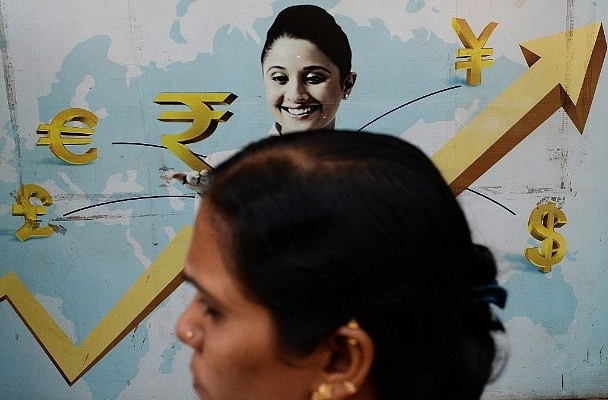Economy
India, China, And The Twin Balance Sheet And Fake Data Problem
- Fudging of data in the case of China, and India’s twin balance sheet problem are challenges facing the two major global economies.

Indian Economy snapshot (INDRANIL MUKHERJEE/AFP/Getty Images)
The year 2017 has been a stressful one for both the economies of China and India. They are both trying to reposition themselves in the world. How much the remedial measures will help these neighbouring economies needs to be seen. That would determine the future growth rates of the two countries.
China’s beige book has warned about the beginning of the impending economic slowdown. Ning Jizhe, Director of the National Bureau of Statistics in China, wrote in People’s Daily, “Currently, some local statistics are falsified, and fraud and deception happen from time to time, in violation of statistics laws and regulations.” The Financial Times analyses that the non-performing assets (NPA) to gross domestic product (GDP) ratio is 25 per cent, which is way ahead of the Chinese government’s claim of 5.4 per cent.
In a nationwide bid to audit the firms, Bloomberg reported, “ten cities, counties or districts in the Yunnan, Hunan and Jilin provinces, as well as the southwestern city of Chongqing, inflated fiscal revenues by 1.55 billion yuan ($234 million),” the National Audit Office said in a statement on its website dated 8 December.
This happened in January 2017 too, when Chinese city Liaoning accepted that it had fudged the fiscal data for three years from 2011 to 2014. President Xi Jinping called for “seriously punishing statistical falsification and fraudulent behavior.” The International Monetary Fund (IMF) made a stinging remark on China in its Financial System Stability Assessment report about the expansionary monetary and fiscal policies aimed at supporting employment and growth where non-viable firms are open to providing jobs rather than allowing them to fail. It argued that “the system’s increasing complexity has sown financial stability risks and advised to improve regulation, and moving toward functional supervision.”
The entire fake data was accepted earlier both by the United States (US) and the international financial institutions due to strong US-China collaboration. With this under strain, the Chinese government is trying to correct the data.
The second-biggest problem is that in the face of failing international demand, China is trying to find markets for the ‘world factory’ in them, and with their newfound power, they are trying to find markets through financial muscle and coercion. The “One Belt, One Road” is one example where they are even taking up unviable projects along the way to increase demand for their factories. This is in sharp contrast to Deng’s policies where he only spoke of cooperation. Whether the policy of forcing projects in other countries will succeed is yet to be seen. The administration has made clear that it will force its way, expressed through its ambassador stating in Washington that China is very strong, and no nation or group of nations can come in its way.
India has its own problems. The country was reeling under the throes of the twin balance sheet problem after 2008, identified in the Economic Survey of 2015. The balance sheet problem of rising public sector bank debt and corporate losses occurred in many other countries, especially in advanced countries, in the recent years. But in India, unlike in Japan and the US, the problem has some unique features. In Japan, there was a balance sheet problem after the real estate and equity boom of the late 1980s. Similarly, in the US, there was a balance sheet problem after the global financial crisis. In South East Asia, the problem occurred when countries borrowed excessively for unviable projects, and had a crisis in the late 1990s.
The Economic Survey elaborates three reasons for why India’s syndrome is distinctively an Indian "balance sheet syndrome with Indian characteristics.” First, India is not suffering from recession or stagnation (in Japan and the US, there was recession). Second, in India, the macro-economic demand is not weak. Rather, there is a moderately strong demand (at least relative to supply) reflected in moderately high inflation and current account deficit. The government has taken actions like demonetisation, the insolvency and bankruptcy code and recapitalisation of banks to improve the situation.
India is rapidly growing. Its NPAs have been analysed as not fake. The main problem is their rise to 12-9 per cent for public/private sector now from the 2 per cent of 2009, courtesy unsound infrastructure projects financed after the boom years of 2005.
It needs to be seen which of the two neighbours sorts out their problems faster.
Support Swarajya's 50 Ground Reports Project & Sponsor A Story
Every general election Swarajya does a 50 ground reports project.
Aimed only at serious readers and those who appreciate the nuances of political undercurrents, the project provides a sense of India's electoral landscape. As you know, these reports are produced after considerable investment of travel, time and effort on the ground.
This time too we've kicked off the project in style and have covered over 30 constituencies already. If you're someone who appreciates such work and have enjoyed our coverage please consider sponsoring a ground report for just Rs 2999 to Rs 19,999 - it goes a long way in helping us produce more quality reportage.
You can also back this project by becoming a subscriber for as little as Rs 999 - so do click on this links and choose a plan that suits you and back us.
Click below to contribute.
Latest